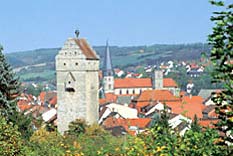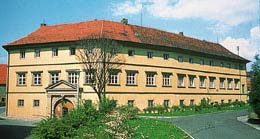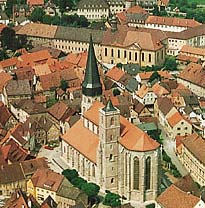|
|
 |
 |
 |
|
 Muennerstadt Muennerstadt
The Counts of Henneberg |
|
In the 12th century the Counts of Henneberg increase their property in the Muennerstadt area. They build a fortress where River Lauer and River Talbach meet. The inhabitants of ancient Muennerstadt village leave their little sheltered houses and settle in the shade of the protecting castle walls. Around the year 1230 the fortified city of Muennerstadt developed quickly: a town wall is built (1251), four town gates, a marketplace (1272), a town court and a town council (1279). Commerce and trade begin to flourish. In the year 1287 Muennerstadt received an official municipal seal.
The corn measuring of Muennerstadt is current in 38 villages and cities of northern Lower Franconia. |
|
 |
|
|
|
 |
|
Around 1231 the Teutonic Order takes possession of Muennerstadt rectory. In 1279 Augustine monks founded a monastery at the request of the citizens of Muennerstadt. The Counts of Henneberg promote commerce and craft.
With their tremendous influence the Counts of Henneberg get Emperor Ludwig den Bayer (the Bavarian) to award municipal law to the flourishing town on 3rd July 1335. In the following years Muennerstadt city which is very well-fortified at that time becomes an important bastion against the prince bishops of Wuerzburg. But inheritance and financial problems finally enable the prince bishops to come into possession of several districts of Muennerstadt city in 1354. The citizens however want to shake off the governance of both the counts and the prince bishops and become a free city. A rebellion fails, a new city order sorts out life within the town wall from 1385 on. |
|
|
|
|
|

|
|
|
|
Local History of Muennerstadt |
|
The region around today's Muennerstadt city is an ancient settlement area. Archaeological finds from New Stone Age (4500–2100 BC) to Hallstatt Age (starting in 750 BC) prove that already thousands of years ago men cleared the forests, tilled the fields and did business there.
On 3rd July 1335 Muennerstadt received municipal law by Emperor Ludwig dem Bayern (the Bavarian).
In 1492 Tilman Riemenschneider built his first winged altar in Muennerstadt. It is an important work of art of the Gothic period. In 1504 famous artist Veit Stoss paints that altar and makes the four panels of the Legend of Saint Kilian.
In the year 1585 prince bishop Julius Echter of Mespelbrunn acquires that part of the city which does not belong to the prince bishops of Wuerzburg and enforces a counter-reformation there. |
|







